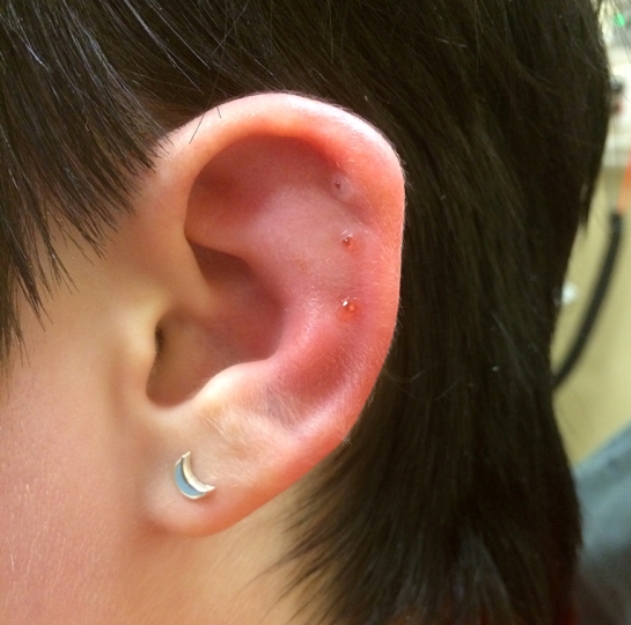Body piercing is very popular now a days. It is equally popular among men and women. Many areas of the body are used for piercing. There are many who have piercings and do not develop any problems. The ears are the most common piercing site Generally, piercings on the upper part of the ear, the cartilage, is common as well as are much more dangerous than earlobe piercings.
Piercing at the cartilage is common because it gives the ear shape. But at the same time, this area is more prone to infections that are much harder to treat since they hardly respond to antibiotics. Piercing ear cartilage creates a wound that is harder to clean, takes longer to heal, and is more likely to become infected than earlobe piercing. Furthermore, there is a higher prevalence of infection on cartilage than earlobe. If your pierced cartilage gets infected, ensure you get it treated as soon as possible.
It is said that if the cartilage area becomes infected, you may develop a painful abscess. This is because the skin is close to the underlying cartilage and pus can become trapped. In case of an abscess, you need to go for surgery to remove it since antibiotics might not be of much help. Such surgical procedures require removal of the affected cartilage and as a result, could deform your ears. Other risks associated with piercing on the ear cartilages include Hypertonic scarring, Boils, perichondritis and piercing bump. Some people often develop cartilage piercing bumps on the back or from part of their ear cartilage.

Infected Cartilage Piercing Symptoms, Treatment
Here you can find all relevant information about Infected Cartilage Piercing including its causes, symptoms and treatment.
Causes of Infected Cartilage Piercing
It is often said that Infections on any body piercings often come as a result that related to the piercing process and after piercing care. Some of the common causes of ear cartilage piercing infection include the following:
- One of the most common cause of infections is the use of unsterilized equipment such as unsterilized needle, gun and other equipment. Such infection are usually bacterial infection.
- Another major cause of such infections are jewelry which is used by the people. Users suffer from allergic reaction that often lead to more serious infection due to the use of such jewelry. Mostly the material of jewelry doesn’t suit the person using it, such as Nickel has been noted to cause allergic reaction to many people.
- Poor personal hygiene during the healing process or even years after, is known as another cause of infected pierced ear cartilage . You should follow the aftercare routine and never touch your piercing with dirty hands, even years after. Do not let other people touch your piercing also.
- Sometimes, they are just your hairs which are responsible for infection. Just tie your hair nicely and in such a way that it does not touch your piercing for the first few days after you have been pierced.
- Make sure that your pillow and bed sheets are also be changed and sterilized each day.
- Other causes of cartilage ear piercing infection may include physical injuries especially when wearing a jewelry, partying. Over cleaning of the piercing can also cause infection.
Symptoms of infected cartilage piercing
You may have infected cartilage piercing, if you are one of the below given symptoms. It’s important to make sure that you go for treatment as early as possible. Some of the common symptoms include the following:
- You may feel tenderness and pain on your cartilage
- You observe redness of the skin around the piercing that lasts more than a few days in case of a new piercing.
- If you are noticing discharges from the piercing site on your cartilage including pus that might be green or yellowish in color.
- If you feel the area around the piercing site often hot
- Fever in severe cases, especially if you have been infected by Pseudomonas aeruginosa that cause Perichondritis.
- If there is prolonged bleeding on your piercing.
Treatment of infected cartilage piercing
It is strongly recommended that you should go to doctor if you notice anyone of the above given symptoms. Some recommended treatments for infected cartilage piercing are following:
Strong antibiotics
As mostly piercing infections are bacterial, that’s why the most recommended way to treat cartilage piercing infection is by the use of antibiotics. A qualified medical practitioner must first verify that your infection is caused by bacteria. Be aware that use of the ordinary prescribed antibiotics such as amoxicillin might not help, because the cartilage has very little blood supply. You have to get stronger prescriptions.
Saline solution
For minor to mild infection, using saline solution may help. This is a natural way to heal an infected cartilage piercing which is often also used to care for the piercing during the healing process.
Anti-bacterial ointments
You can also use an anti-bacterial ointment if the infection is mild. But you need to seek for a doctor’s approval since ointments affect the draining process and this can slow down healing of your piercing.
 Health & Care Information
Health & Care Information 

